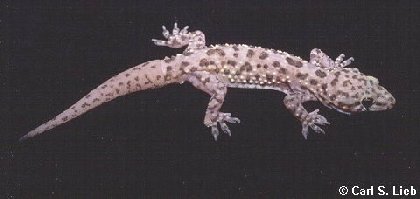
Vertical walls may not slow down Spiderman, but he's really somewhat of a piker when it comes to getting around. Like many of us, the Mediterranean Gecko is a transplant who has come to love the desert. And they've proven this by doing very well in Las Cruces, El Paso, and presumably points south.
This small lizard, with a body length of little over 2 inches, gets
along well with people, perhaps as a result of a long history of common occupancy of
the Mediterranean world. In fact, it's pretty much limited to metropolitan areas,
where it may nonchalantly stroll, upside down, across your porch ceiling on its way to
munch on small insects attracted to a light. Specialized toe pads allow such
acrobatics. Perhaps luckily, it's mostly nocturnal, usually avoiding being seen by
narrow-minded homebodies who might object to little critters running up and down walls.
A widespread superstition accuses them of being venomous. Contrariwise, they are
harmless except under one condition. And what's that condition? That you happen to
be no bigger than a housefly! 
Contributor: Arthur H. Harris, Laboratory for Environmental Biology, Centennial Museum, University of Texas at El Paso.
Desert Diary is a joint production of the Centennial Museum and KTEP National Public Radio at the University of Texas at El Paso.

Mediterranean Gecko. Photograph by Carl S. Lieb.
Degenhardt, W. G., C. W. Painter, and A. H. Price. 1996. Amphibians and reptiles of New Mexico. University of New Mexico Press, Albuquerque. 431 pp.